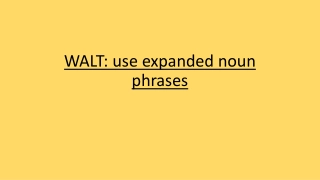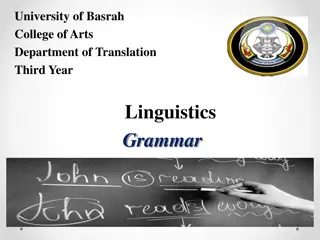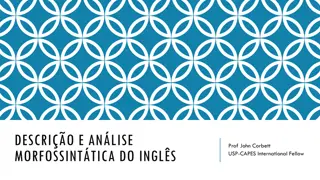Enhancing Writing Through Detailed Noun Phrases
Explore the LEAD principles for connecting grammar with meaning and rhetorical effect in writing. Authentic texts are utilized to engage learners in deep metalinguistic learning. An interactive activity challenges readers to match descriptions with marine creatures based on detailed noun phrases. Delve into the importance of noun phrases in conveying specific details in texts through examples from the animal kingdom.
Download Presentation

Please find below an Image/Link to download the presentation.
The content on the website is provided AS IS for your information and personal use only. It may not be sold, licensed, or shared on other websites without obtaining consent from the author.If you encounter any issues during the download, it is possible that the publisher has removed the file from their server.
You are allowed to download the files provided on this website for personal or commercial use, subject to the condition that they are used lawfully. All files are the property of their respective owners.
The content on the website is provided AS IS for your information and personal use only. It may not be sold, licensed, or shared on other websites without obtaining consent from the author.
E N D
Presentation Transcript
Making information detailed and precise by using expanded noun phrases
LEAD Principles PRINCIPLE LINKS EXPLANATION RATIONALE To establish a purposeful learning reason for addressing grammar, and connect grammar with meaning and rhetorical effect Make a link between the grammar being introduced and how it works in the writing being taught To avoid writing lessons becoming mini- grammar lessons, and to allow access to the structure even if the grammar concept is not fully understood To integrate reading and writing and show how real writers make language choices EXAMPLES Explain the grammar through examples, not lengthy explanations AUTHENTIC TEXTS Use authentic texts as models to link writers to the broader community of writers To promote deep metalinguistic learning about why a particular choice works, and to develop independence rather than compliance DISCUSSION Build in high-quality discussion about grammar and its effects
Authentic text Who s who? Match the descriptions to the right animal. Which description gave the best clue to each creature, and why? Discussion A: octopus B: sea anenome C: swordfish D: shark E: jellyfish very streamlined bodies; large migratory fish; ability to see in deeper water; unique elongated upper jaw 1. streamlined design; a very fast swimmer; the largest predatory fish in the ocean; the most powerful jaws on the planet 2. toxic tentacles; bell-shaped bodies; gelatinous, jelly-like creatures that have been in our seas for over 650 million years, making them older than the dinosaurs 3. three hearts; blue blood; a large central brain; eight minor brains located at the base of each arm 4. cylindrical body; central mouth; long tentacles that fire harpoon-like filaments into their prey Answers: A4; B5: C1; D2; E3 5.
Authentic text Noticing details in a text If you took out the noun phrases from these sentences, what would you be left with? Examples Sharks are the largest predatory fish in the ocean and with their lightweight skeleton and streamlined design they are also speedy swimmers. Sharks have the most powerful jaws on the planet and, on average, five rows of teeth holding 3000 teeth at a time! The female anglerfish has a protruding dorsal spine that hangs over its mouth like a fishing pole. Unlike other scaly fish in the ocean, a seahorse s body is covered in hard, bony plates that are fused together and covered in a layer of flesh. Links In information texts, the noun phrase unit often creates most of the detail in a sentence. In these examples, noun phrases help the reader understand what is special about each creature, describing their features clearly and precisely.
Match the right answer with the right question. The noun phrases are highlighted. Practise using these in complete sentences that describe each creature s special feature. What do all snakes have? an elephant a lengthy, flexible neck 60-72 sharp teeth that are made to crush not chew Which is the largest land-living animal in the world? an impressive ability to swallow their prey whole. What insects are eight-legged predatory anthropods with a segmented venomous stinger? sweet nectar What does a giraffe use to reach for leaves, fruit and flowers? How many teeth does a crocodile have? scorpions What do honeybees collect from flowers?
Verbalising the Grammar-Writing Link A crucial element of the LEAD principles is helping writers to think explicitly (metalinguistically) about the choices they make. As a teacher, you need to support this by being crystal clear yourself about how you verbalise the link between a grammar choice and its effect in a particular text/context. Then express this in student-friendly language, as below. Verbalisation to share with students: When you are writing to inform and explain, you will often need to provide your reader with detailed and precise descriptions so that they understand the topic you are writing about. An important way of providing precise detail is by using expanded noun phrases. Think about how you can build detail around the key noun to give a really clear description.

 undefined
undefined


























